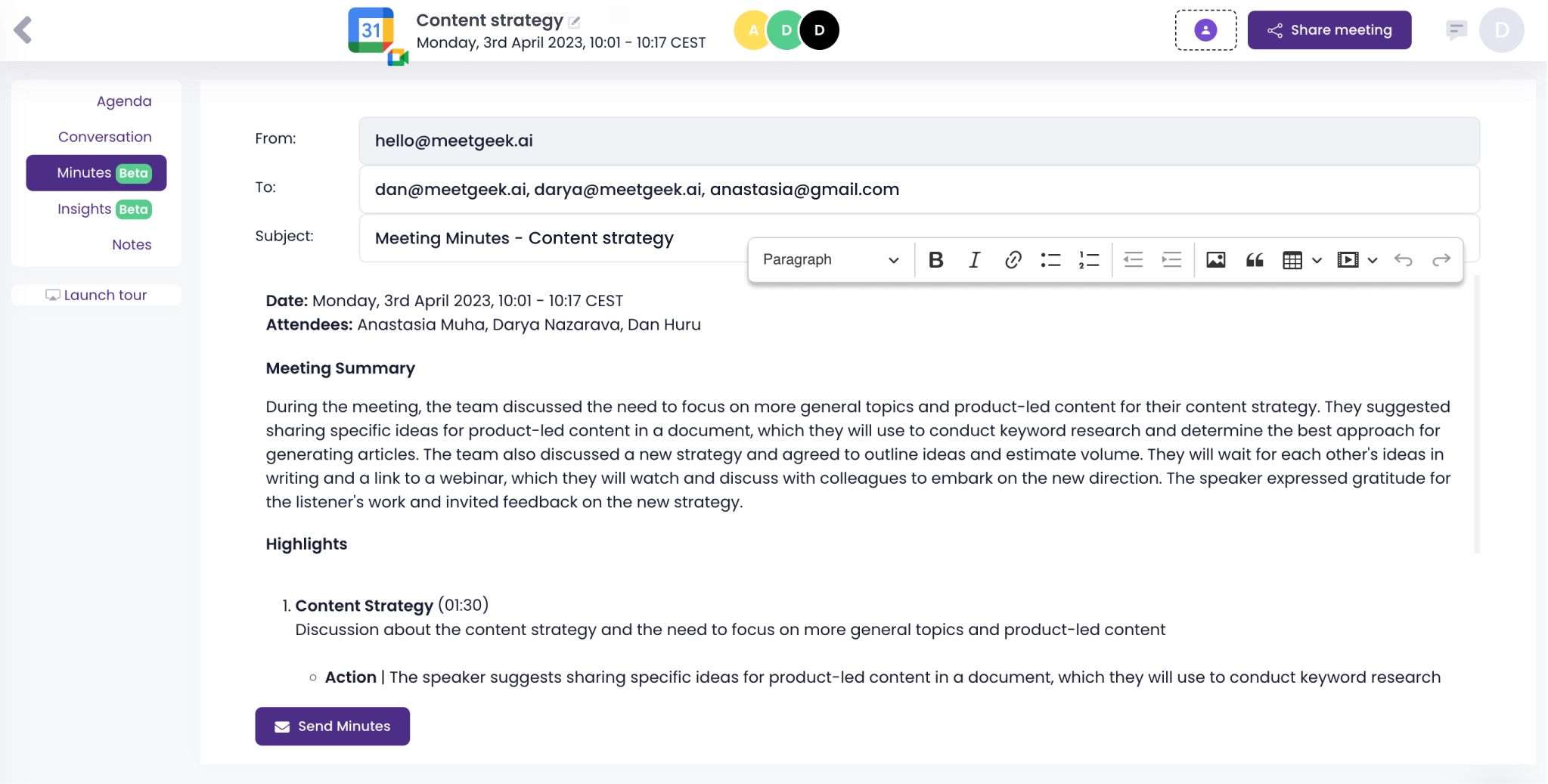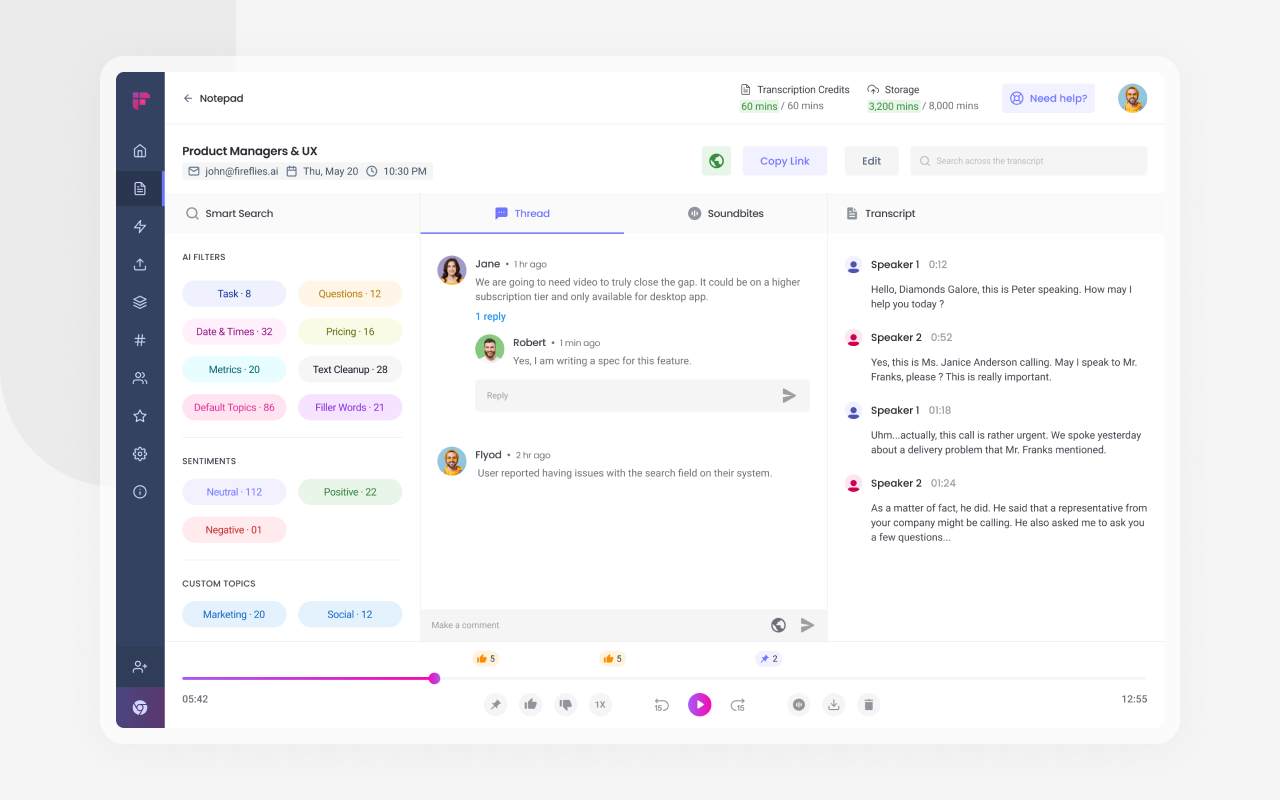As a busy professional, you’ve probably found yourself forgetting important details from time to time. Whether a meeting finishes, and you can't recall the action items you're responsible for, or you're scratching your head trying to remember crucial details to get started on your task list, there is never a shortage of scenarios in which it's crucial to remember meeting details. In a world where we’re constantly being bombarded with notifications, meeting invites, and big asks, keeping track of pertinent information is now more important than ever. To avoid miscommunication, prioritize effective meeting management, and hold your teammates accountable, it's crucial to record Microsoft teams meetings and share recorded teams’ meetings.
Recording your meetings in teams will ensure you and your teammates have a detailed record of everything that transpires during each meeting, and these recordings can be used to verify decisions, and serve as a reminder of past events and actions. Additionally, letting teammates know that you will be initiating a Microsoft Teams meeting recording will boost meeting participation and engagement. In this article, we’ll cover everything from learning how to record Microsoft Teams meetings to teams recording storage details, Teams meeting compliance, and much more.
Why Record Microsoft Teams Meetings?
When determining whether to record Microsoft Teams meetings or refrain from recording, it's important to consider the multitude of benefits. Capturing a Microsoft Teams Meeting recording during your next meeting will ensure you have an accurate record of your meeting. In addition, teammates that weren’t able to attend will have equal access to the information.
It’s important to note that while Teams meetings or calls can be recorded, both the meeting facilitator and the recording initiator must have recording permission to record the meeting. Recording within Microsoft Teams is not enabled by default and is only available when you are in a meeting. If the “recording” option is grayed out on your screen, it may be because you don’t have permission to record the Microsoft Teams meeting. To proceed, you must request permission to record. Given Microsoft Teams meetings usually cover several action items, it's important to go the extra mile and record your meeting. This will ensure you're able to effectively communicate and follow up on action items while making sure your teammates have equal access to information, regardless if they were able to attend the meeting.
Oftentimes organizations will opt for Compliance Recording which refers to the process of automatically recording meetings based on corporate, regulatory, or administrative policy. If an external Teams user that has enabled Compliance Recording joins a meeting or call hosted by your organization, that meeting or call will be recorded by the other organization for compliance purposes regardless of the meeting recording settings in your organization. Compliance Recording can be enabled on Microsoft 365 A3/A5/E3/E5/Business Premium, Office 365 A3/A5/E3/E5 users, Teams Rooms license, or Microsoft Teams Shared Devices license.
Preparing to Record a Meeting in Teams
There are a number of steps that must be taken prior to recording your Microsoft Teams meeting. Keep reading to learn the basics!
1. Seek permission
Before you record Microsoft Teams Meetings, it's important to first seek permission. This means seeking permission from your manager and your peers, and ensuring you have the proper permissions to capture the actual recording. For Microsoft Teams in particular, both the meeting facilitator and the meeting initiator must have the proper permissions before recording the meeting. This can be done by visiting the Microsoft Teams admin center, expanding the meetings tab, and selecting “turn meeting recording on”.
2. Inform meeting participants
Before you record Microsoft Teams meetings, it's important to inform your teammates. This means taking the time to set meeting ground rules and let meeting participants know you will be recording your meetings. You can let them know prior to the meeting via your meeting invitation, or kickoff your next meeting with a simple statement to advise them of the recording.
3. Set meeting ground rules
When preparing to record Microsoft Teams meetings, it's important to set meeting ground rules. The ground rules you choose will largely depend on your unique values and organizational rules. Examples may include asking meeting participants to mute their microphones when they aren’t speaking, asking participants to raise their hand before speaking, or encouraging your teammates to stick to the meeting agenda.
4. Technical setup
Before you record meetings in Teams, you must first ensure you have the proper technology. This means you will need a working laptop or desktop to host or facilitate the meeting, and you will need to familiarize yourself with Microsoft Teams. Luckily, you can record Microsoft Teams meetings natively within Teams. This means you don’t need to exit the app or software to capture a Microsoft Teams meeting recording.
5. Provide technical training
To share recorded Teams meetings, save Teams meetings, and access Teams recordings, you must provide internal training. Familiarizing yourself with Teams and affording your teammates the same opportunity will ensure ease of use. Remember, you want to integrate a new tool into your tech stack that is easy to use and access.
How to Record a Meeting in Microsoft Teams
A step-by-step guide to start recording:
- Start or join the meeting.
- Go to the meeting controls and select More actions > select Record and transcribe, then select Start recording.
A step-by-step guide to stop recording:
- Go to the meeting controls and select More actions and select Record and transcribe.
- Choose one of the following:
- Stop recording: Stops the recording and live transcription.
- Stop transcription: Stops just the live transcription. The recording continues until you select Stop recording.
A step-by-step guide to find recordings:
- Recordings are available in different places depending on the type of meeting:
- The recording is processed and saved to SharePoint if it was a channel meeting or OneDrive if it was any other type of meeting.
- The meeting recording shows up in the meeting chat or channel conversation (if you’re meeting in a channel).
- Presently, guests and external attendees can only view the meeting recording if it has been shared with them by the meeting host or facilitator.
Who can record a Teams meeting?
It's important to note that not everyone will have the ability to record a Microsoft Teams meeting. In order to record, you must meet the following criteria:
- Have the recording activated by an IT admin.
- You are acting as the meeting facilitator or someone from the same organization.
- Have either an Office 365 Enterprise E1, E3, E5, F3, A1, A3, A5, Business Essentials, M365 Business, or Business Premium license.
Best Practices for Microsoft Teams Meeting Recordings
When learning how to effectively record Microsoft Teams meetings, it's important to set time aside for preparation. Like in-person meetings, preparation is the key to hosting and recording effective virtual meetings. You will want to make sure all meeting participants receive the meeting invite, meeting agenda, any relevant documents, and the meeting link. After the basics have been taken care of, you can get to work on facilitating and recording your meeting in Teams.
Whenever possible, encourage meeting participants to participate in the conversation. You can't initiate an effective recording without first facilitating an impactful conversation that follows a meeting agenda. While conversation and engagement are both important, you must set ground rules that encourage meeting participants to participate in accordance with the meeting agenda. To ensure a quality recording, you must remind teammates to refrain from speaking over one another and to follow the meeting agenda. Additionally, meeting participants should be reminded to mute their microphones when they aren’t speaking to ensure the Microsoft Teams meeting recording isn’t muffled, confusing, or hard to follow.
Additional best practices include:
- Staying focused
- Creating a meeting agenda
- Setting meeting ground rules
- Limiting background noise or distractions
- Muting your microphone when you aren’t speaking
- Leveraging body language and practicing active listening
Alternative tools to record Microsoft Teams meetings
1. Fellow
Are you looking for a tool that will complement the recording feature in Microsoft Teams? Fellow is a meeting management tool that empowers managers to take their meetings to the next level with several intuitive features backed by AI. Features include but aren’t limited to AI generated meeting agendas, action item tracking, feedback facilitation, real-time note taking, comprehensive transcriptions, and so much more! Instead of sifting through document after document after your Teams meeting has ended, you can rest easy knowing that meeting recordings, transcriptions, and summaries are linked to every meeting and calendar with Fellow.
Leveraging Fellow’s AI meeting assistant in tandem with your Microsoft Teams recording will ensure all of your teammates have equal access to pertinent information. Fellow’s AI meeting summaries provide all the key takeaways from your meetings in minutes so you can revisit discussions and align around next steps without having to worry about sourcing the proper information. Fellow acts as a central repository for all meeting records so everyone is aligned, engaged, and on track. The best part? Teammates that couldn’t attend can catch up on key discussions and insights when they miss a meeting and AI meeting summaries, meeting recordings, and full transcriptions can be shared in a matter of minutes.
.webp)
2. Meetgeek
Did you know that you can use MeetGeek in tandem with Microsoft Teams to enhance your Microsoft Teams meetings? Meetgeek is a meeting productivity software integration that can be integrated with Microsoft Teams to automatically record, transcribe, and distribute meeting highlights to meeting participants. MeetGeek integrates seamlessly with your calendar and will automatically join your Microsoft Teams meetings to provide a concise summary. Meeting notes, meeting minutes, and summaries will then be generated automatically and sent to your inbox promptly when the meeting finishes, making it quick and easy to align and inform your team.
If you're interested in enhancing meeting outcomes with AI, you can get started with the free plan. For additional functionality, you can upgrade to the pro plan for $15/ month per user.

3. Fireflies.ai
Fireflies.ai is another excellent resource that can be used in tandem with Microsoft teams to enhance the meeting experience. Fireflies.ai is a meeting assistant that can be used to capture meeting summaries and derive meeting insights. When used with Microsoft Teams, Fireflies.ai can be used to capture comprehensive meeting notes by joining your Teams meeting at the start of your meeting to record, transcribe, and take meeting notes. Your notes will automatically be sent to Microsoft Teams in your team and channel of choice. A link to your call transcript, audio recording and brief notes will be included.
Fireflies.ai offers a variety of plans at different price points, making it possible for everyone to take advantage of AI meeting summary tools. Plans range from a free plan for beginners to a business plan that is priced at $19/month per user.

Boost meeting productivity with Fellow and Microsoft Teams
Fellow’s Microsoft Teams integration prompts meeting attendees to add talking points to the agenda and prepare for the meeting in advance, ensuring that your meetings start and end with clarity every time. Fellow even makes it easy to send and respond to feedback about meetings, projects, and performance right from the Microsoft Teams app, ensuring crucial details are never missed or forgotten. Collaborating on meeting agendas, taking minutes during your video calls, and sending feedback requests without leaving your chat app has never been easier. Interested in managing your meeting agendas right within Teams? Click here!
The most accurate and secure AI meeting notetaker
Record, transcribe and summarize your meetings with Fellow, the only AI meeting assistant built with privacy and security in mind.
Get started with Fellow todayLearn more.webp)

